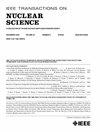基于击前耗尽电容储能的SiC功率器件重离子烧坏物理模型
IF 1.9
3区 工程技术
Q3 ENGINEERING, ELECTRICAL & ELECTRONIC
引用次数: 0
摘要
提出了一种预测SiC功率器件中高线性能量传递(LET)、正入射单事件燃烬(SEB)电压的解析模型。引入了存储在漏体耗尽区并由通过离子释放的临界能量的概念,并用于推导仅取决于外延层掺杂的高let,正常入射(最坏情况)SEB电压的表达式。通过1200 ~ 4500 V的实验数据验证了模型的正确性。实验证明了高let、正入射SEB和外延层厚度的相对独立性,并得到了模型的支持。对900 V SEB电压器件进行了实验验证。用该模型解释了SiC器件的降额因子随电压的变化规律。集总RC模型用于获得对低和高let离子的SEB的见解。低let SEB响应似乎与功率密度模型和热尖峰效应一致。高let SEB响应在性质上类似于单事件门破裂(SEGR),耗尽电容作为能量存储元件。描述了对seb优化SiC功率器件的影响。本文章由计算机程序翻译,如有差异,请以英文原文为准。
Physical Model for SiC Power Device Heavy-Ion Burnout Based on Pre-Strike Depletion Capacitance Energy Storage
An analytical model for predicting high-linear energy transfer (LET), normal incidence single-event burnout (SEB) voltage in SiC power devices is presented. The concept of critical energy stored in the drain-body depletion region and released by the passing ion is introduced and used to derive an expression for high-LET, normal incidence (worst case) SEB voltage that depends only on epitaxial layer doping. The model is validated by experimental data ranging from 1200 to 4500 V. The relative independence of high-LET, normal incidence SEB, and epitaxial layer thickness is demonstrated experimentally and is supported by the model. The 900 V SEB voltage devices are experimentally demonstrated. The derating factor for SiC devices as a function of voltage is explained with the model. A lumped RC model is used to gain insights into SEB for both low- and high-LET ions. Low-LET SEB response appears consistent with power-density models and thermal spike effects. High-LET SEB response is qualitatively similar to single-event gate rupture (SEGR), with the depletion capacitance as the energy storage element. Implications for SEB-optimized SiC power devices are described.
求助全文
通过发布文献求助,成功后即可免费获取论文全文。
去求助
来源期刊

IEEE Transactions on Nuclear Science
工程技术-工程:电子与电气
CiteScore
3.70
自引率
27.80%
发文量
314
审稿时长
6.2 months
期刊介绍:
The IEEE Transactions on Nuclear Science is a publication of the IEEE Nuclear and Plasma Sciences Society. It is viewed as the primary source of technical information in many of the areas it covers. As judged by JCR impact factor, TNS consistently ranks in the top five journals in the category of Nuclear Science & Technology. It has one of the higher immediacy indices, indicating that the information it publishes is viewed as timely, and has a relatively long citation half-life, indicating that the published information also is viewed as valuable for a number of years.
The IEEE Transactions on Nuclear Science is published bimonthly. Its scope includes all aspects of the theory and application of nuclear science and engineering. It focuses on instrumentation for the detection and measurement of ionizing radiation; particle accelerators and their controls; nuclear medicine and its application; effects of radiation on materials, components, and systems; reactor instrumentation and controls; and measurement of radiation in space.
 求助内容:
求助内容: 应助结果提醒方式:
应助结果提醒方式:


